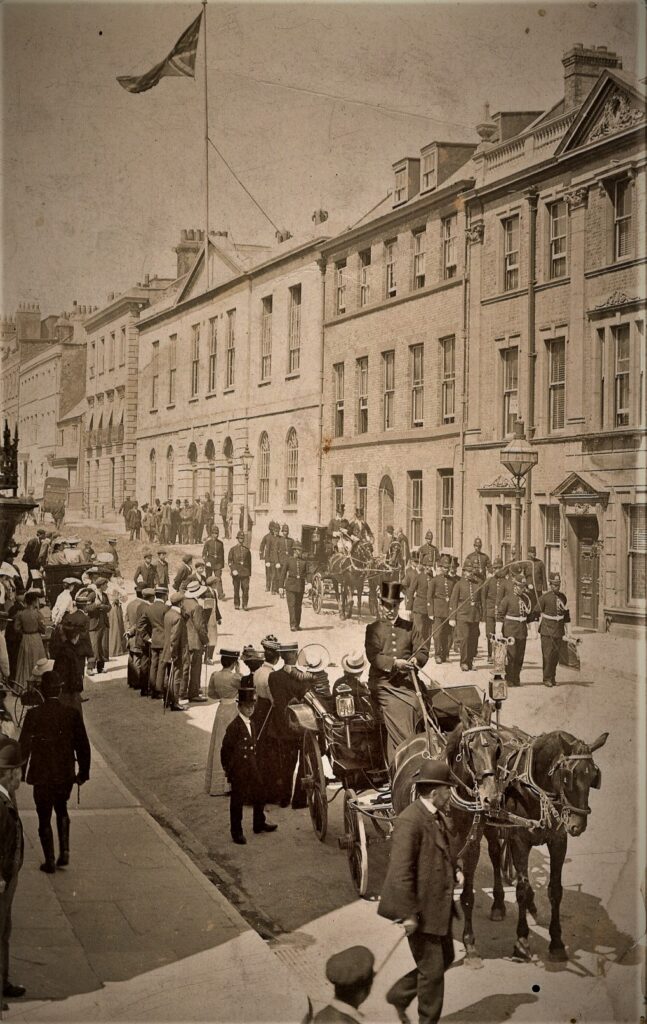
A brief history of the Court Procession and the Dorset police officers that were involved.
In the 12th century, King Henry 2nd introduced the circuit system of administration of justice by which Judges of the Kings Court travelled throughout the Country holding courts called Assizes. The courts met twice a year in lent and summer in each county. The western circuit, around which two Judges travelled, included Cornwall, Devon, Somerset, Dorset, Hampshire and Wiltshire, together with “counties” of Exeter and Bristol. By 1559, they were hearing the most serious cases such as murder, infanticide, theft, highway robbery, rape, assault, coining, forgery, witchcraft, trespass, vagrancy and recusancy. In the 19th century a winter court was also introduced to cope with the excess demand. The court was supposed to last a week but could be less days or weeks for complicated cases and were held mainly at Dorchester and sometimes at Poole in Dorset. The name Assizes, comes from the Latin word, “assideo“ meaning to sit together . Today this court would be called Crown Court.
Initially the Judges travelled by coach and horses far and wide so they needed protection from criminals and highwaymen. The duty of protection was provided by the Sheriff of the County, who would provide local men for the King’s Army and some of these men would be used as an armed escort for the Judge. These men later became known as the “Javelin men”. The Sheriff and his men would meet the Judge and his entourage at the County boundary. Then escort him to his court and chambers and it was his duty to keep him safe until he left the County boundary again. When the railway became efficient and an easier passage of travel in the 19th century, the horses and carriages were no longer required. The Sheriff then met the Judge and his posse at the local railway station and if it was close, they all marched to the Court. In the 20th century the Judge had the option of coming by car.
By the 1840’s the military armed men’s escort was not really required as the Judge’s journey had turned into more of a procession. The armed guard and the heavy armour gave way to the solitary pike like weapon called the javelin, and that is where the name “javelin men“ came from. These javelin men of about twenty in number, were armed with long steel headed staves or metal tipped javelins and the men were described as wearing, a blue tunic and trousers which had a black stripe down the leg.
In the mid 1850’s there were reports in newspapers concerned about the costs of the Javelin men, especially when food and lodgings had to be paid for. More important though, at times the men were ineffective with keeping order in the courts, so that was becoming the main issue. In March 1858, the procession was described in the Western Flying Post paper as: four and twenty javelin men who were headed by two trumpeters, dressed in blue with scarlet waistcoats, bearing a blue flavour in their hats proceeded the carriage and walked from the railway station.
The procession continued as it was for nearly another decade, until the Government decided that it would be better for the police to take over as most county police forces had now been formed. This naturally took longer in some counties than others to be adopted. Some Chief Constables were very concerned that on Assizes weeks they would lose a lot of their man power to the point that some were only willing for two officers to take the place the javelin men squad of twenty.
The ceremonial commitment for the Dorset Constabulary appears to have come into existence in late 1859, when it was discussed at the October Committee Sessions. The Chief Constable at the time, Colonel Cox stated that he could take over without any inconvenience to his Force in Dorset.
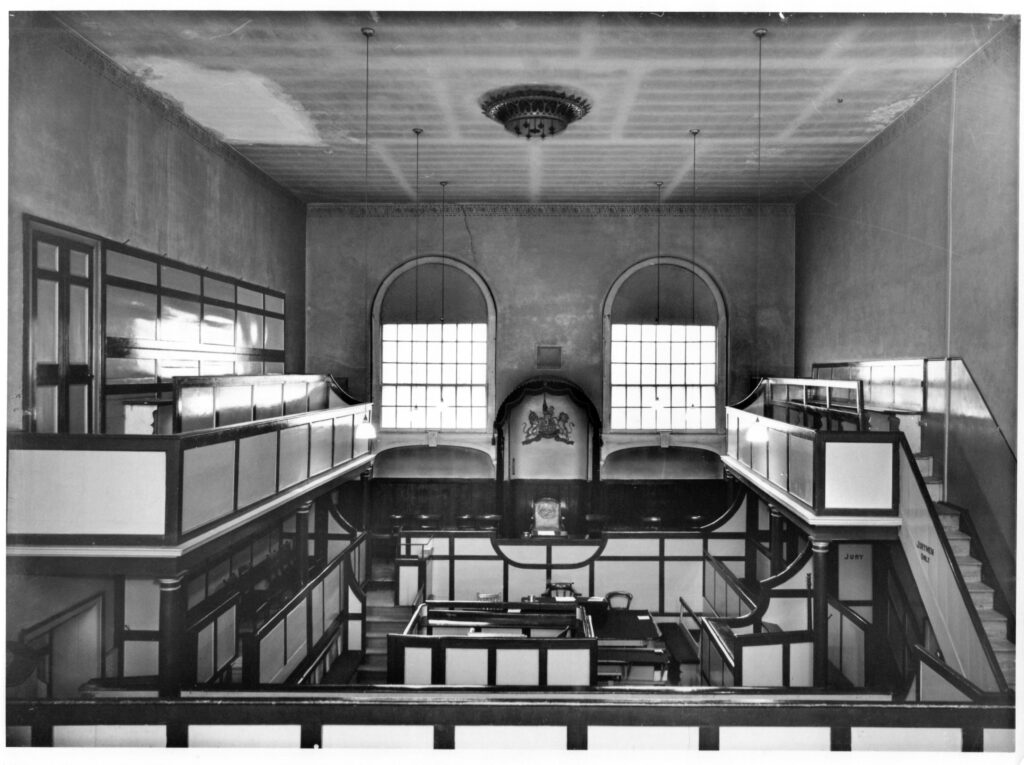
In March 1867 at Dorchester, it was reported that their Lordships Sir Fitzroy KELLY and Mr Justice BYLES arrived at Dorchester and were met by the High Sheriff J.H CALCRAFT, esq. In the place of the usual array of javelin men and trumpeters there officiated, in accordance with a resolution recently passed at quarter sessions, about 24 members of the County police force, who marched in procession in front of the state carriage. These men were all handpicked by the Chief Constable, all tall and similar height and of smart appearance. Naturally many of them had been in the military before joining the police so were especially selected to act as a bodyguard for the Honourable Judge of the Assizes.
The men were summoned from all over the County to parade a couple of days before Assizes. It was customary when the Judge was opening the Assizes Court, at the Shirehall, that prior to the court he would attend a short religious church service at a parish church. In Dorchester’s case this was St Peters Church on High West Street. The High Sheriff, Under Sheriff ( who was a qualifies solicitor) and the judge’s personal servant would also be present. After divine worship the Judge and his entourage would walk in a slow procession with his police bodyguard surrounding them, whilst the two trumpeters would head the procession sounding various calls, voluntaries and fanfares. There were other constables on point duty in the area to make sure no traffic interrupted the procession. When the Judge was inside the court, he would remove his outer garments, and as he was about to take his seat, the trumpeters in the Shirehall entrance would sound a call which demonstrated that Court of Assize was in session. See the next photograph and a closer image of the trumpeters.
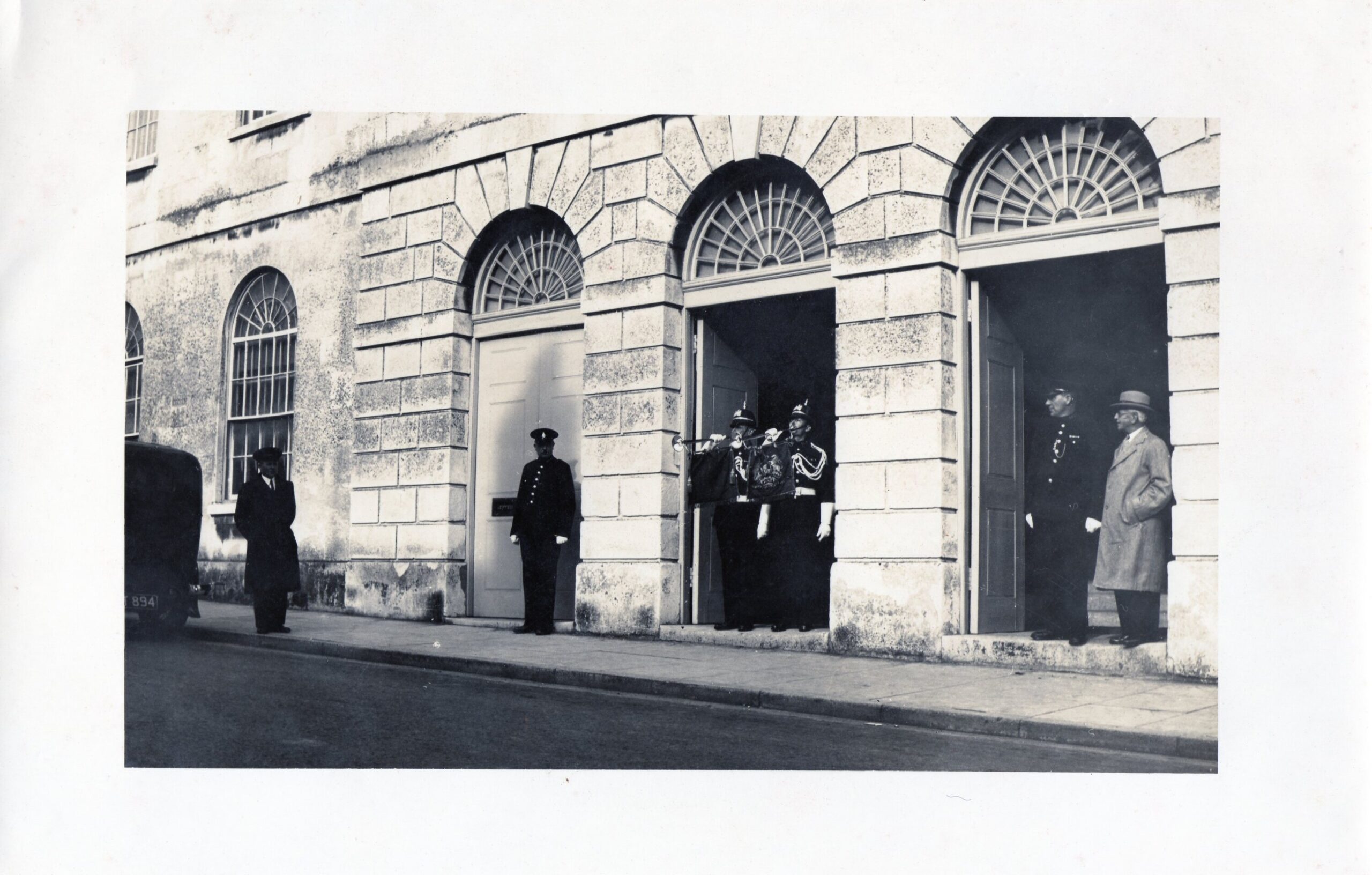

As a reminder of the old type of Javelin men, the police constables on duty would parade with long, thin, bound wooden poles with a metal spearheaded top, a sort of replica of the earlier held by the javelin men. These staves would be used to maintain quiet from all the spectators and witnesses in the court room, when a firm tap on the shoulder was not respected.
The Assizes court was held at the Old Shirehall (above) on High West Street, Dorchester up until the court system changed in 1971. Attached to the Shirehall was the Judges lodgings, where the stewards who waited upon him had living quarters. The last stewards were a couple called Mr and Mrs DAVIDGE. They remained in the building until it was disposed of and the law courts were then held in the County Hall in the grounds of Coliton Park.
Here are all the photographs I have collected and the earliest appears to be from before 1913. The first photograph shows the entrance to the Shirehall and officers with their finial helmets on. The helmets with finials were changed in 1913, exact date not known.
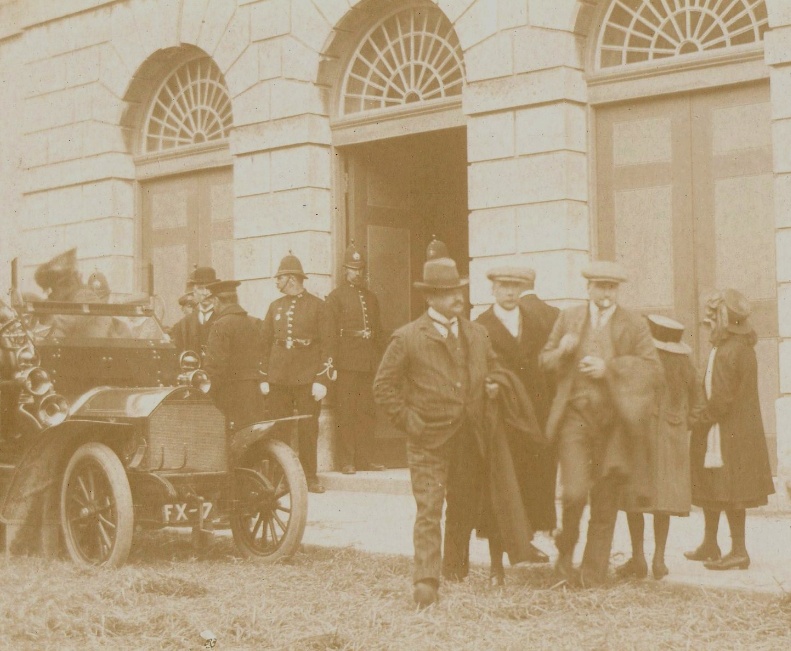
David HANKS, a retired Gloucestershire police officer also has this photograph/card, which is obviously taken just before my above photograph/card and no doubt by the same photographer

The above photograph maybe from the trial of William BURTON who was convicted of murdering Winifred MITCHELL at Gussage St Michael. You can also see a thick layer of straw on the road which was put down when the Assizes took place. The straw was placed on the road to try and stop the noise of horse’s hooves and horse drawn vehicles on the metalled road. This was to help the Judge get some peace in his quarters. George DYER and Fred FALL are shown below.
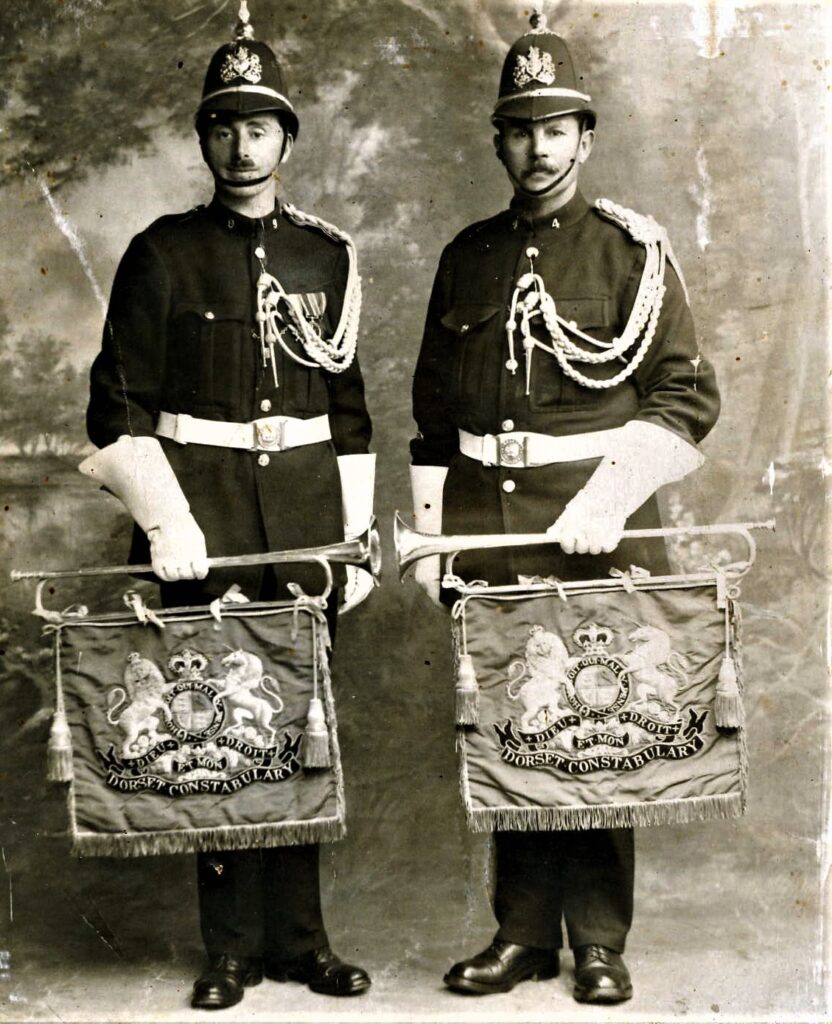
In the 1920’s the Judge moved from his apartment above the court and then had a room at Mrs WILLIAMS house in Queens Avenue.
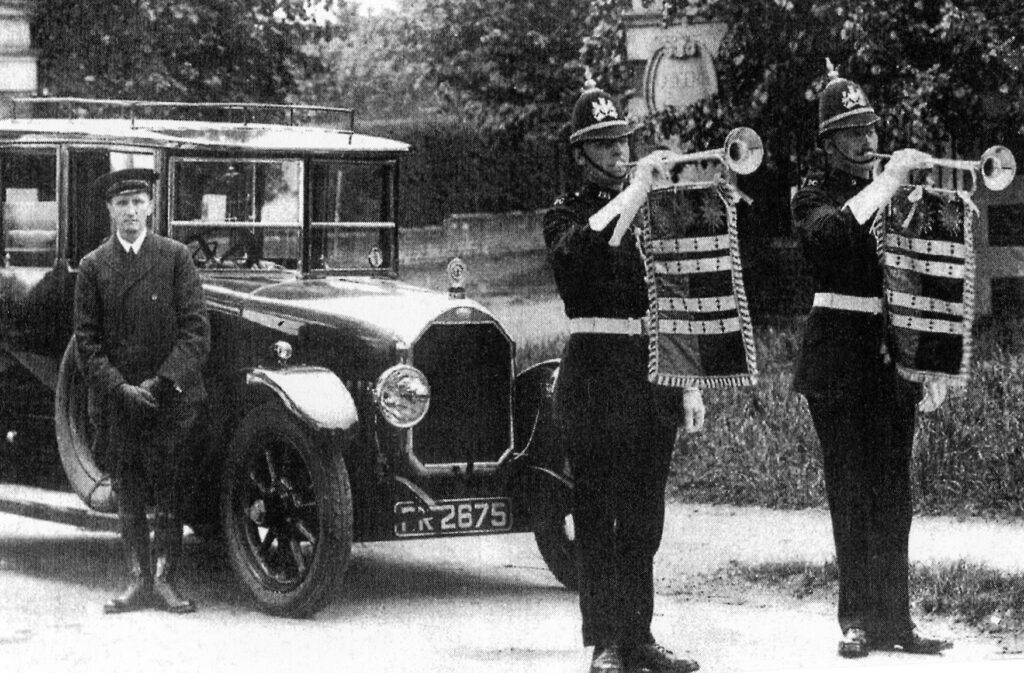
This photograph is from the “ Bobbies on the beat 150 years of the Dorset Police”. Thanks to Melvin HANN for allowing me to use it.
It shows the entrance to Queens Avenue and as the book says, “ The Force trumpeters play a fanfare for the Assizes Judge as he leaves his lodgings in Queens Avenue, Dorchester. Circa 1920.
The photograph must be after October 1925 as that was when Fred FALL retired and the trumpeters are Bill CHASE and George DYER.This next photograph is of the Assizes parade from October 1935.
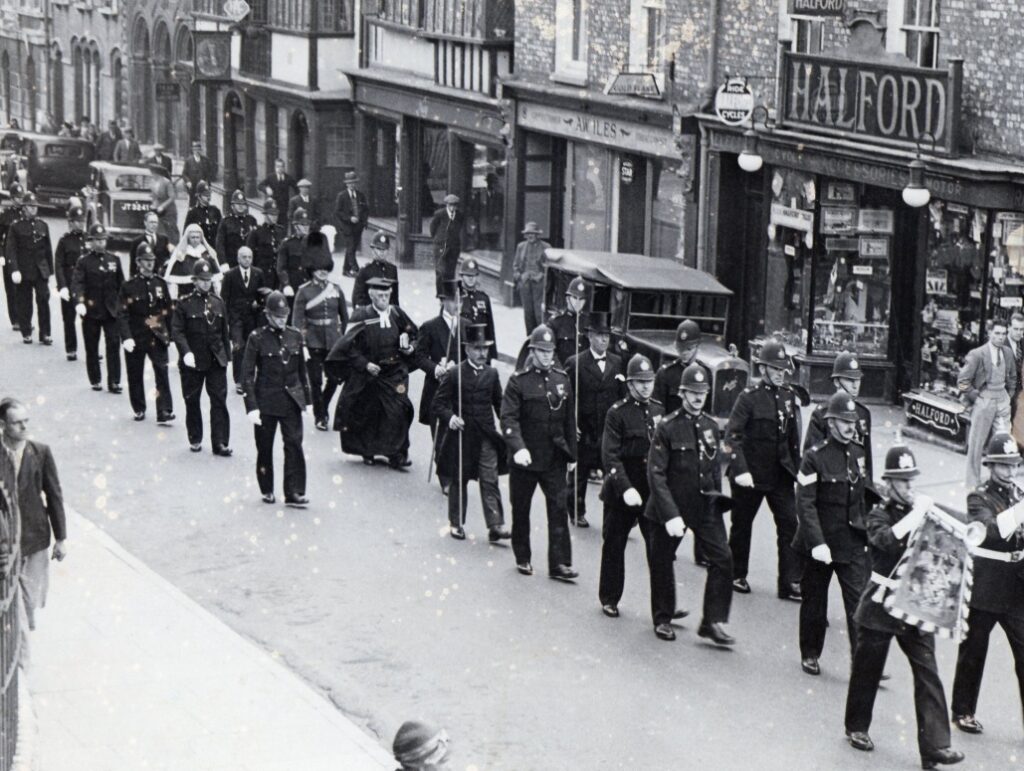
This photograph shows at the head, trumpeters PC’S Bill CHASE and George DYER again followed by the Training Sgt, who I cannot identify and 6 Constables. Then 2 x stave holders, the County Under Sheriff Mr WA FFOOKS, the Chaplain is Canon E.J HELLINS of Marnhull, who is followed by the High Sherriff Major H.DENNISON-PENDER and the Mayor Mr Frederick C. JAMES. Then comes Judge FINDLAY and his personal servant who are guarded by 14 more constables.
The next set of photographs are from 1936 and are probably for the trial of Charlotte BRYANT who was convicted of poisoning and sentenced to death for murdering her husband at Sherborne.
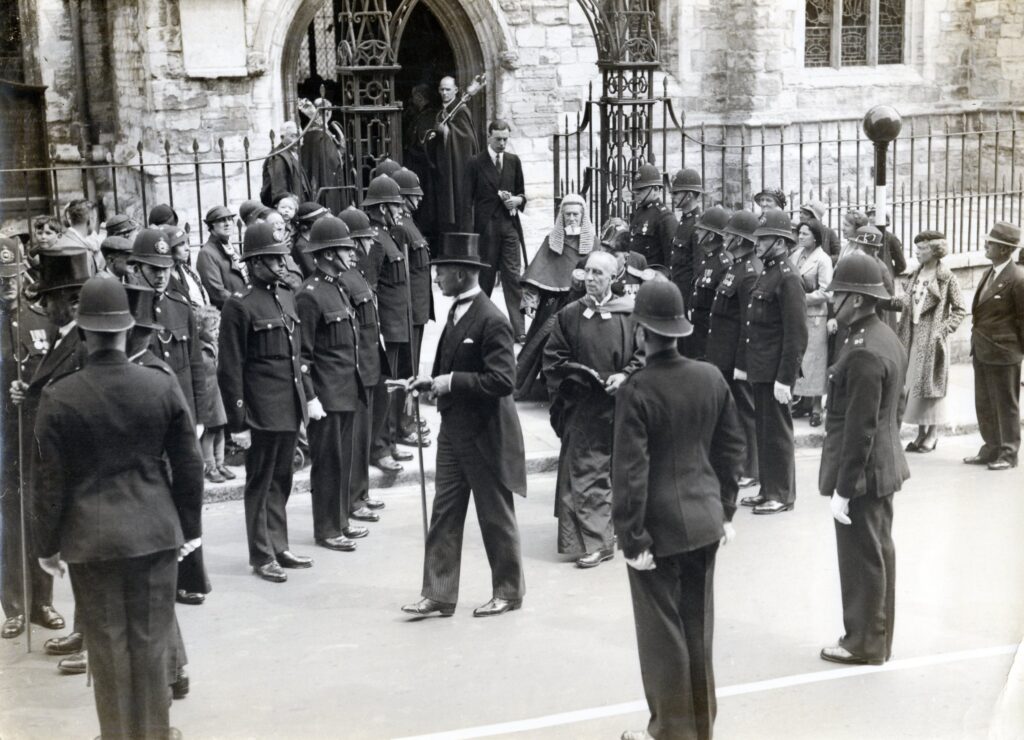
This photograph shows the Judge leaving the church service at St Peter’s Church. In the centre of the photograph is Under Sheriff FFOOKS. Behind the chaplain you can just about see the High Sherriff in his military attire, who is Lieut Commander Hector MUNRO of Edmondesham, near Cranborne. I cannot be sure, but the Judge is probably Judge MacKINNON. Not much has changed outside the church today, except the most of the iron work has gone and the zebra crossing has moved up the street 10 metres.
The next photograph must be after the Assizes has retired as the procession is now heading back down High West Street. The High Sherriff in his military attire is as normal followed by the Judge and his personal assistant.

From the above two photographs you can see some policemen’s collar numbers. Looking closely, I have picked out numbers 4, 149, 160 and 173. Based on the date the officers will be:
4: Clement ARKELL, 149: Herbert GOODCHILD, 160: Harry SHELDRAKE and 173: Maurice LEGG.
The next photograph is from 1947, my grandfather Victor SWATRIDGE is the Sgt, just behind the trumpeters Sgt Bill CHASE and PC Dennis HABGOOD. In charge of the parade on the left is Insp Harry LILL and you can see they have now decided to drive from the church to the court.
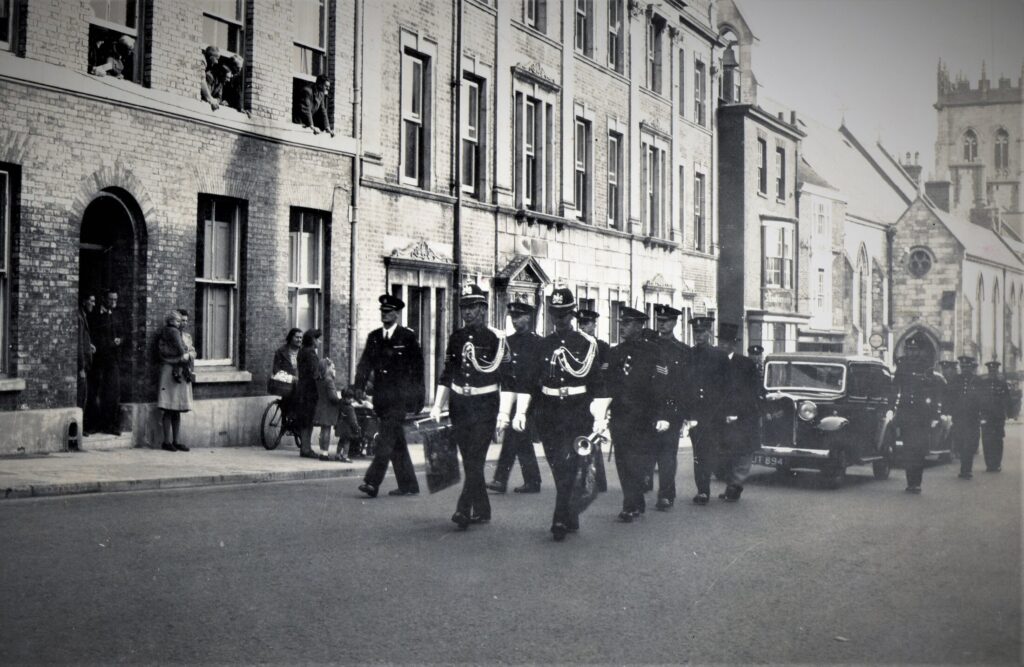
The next photograph is again from the “Bobbies on the Beat, 150 years of Dorset Police“ book . Thanks again to Melvin HANN, the photograph shows PC’s Dennis HABGOOD and Dave BISHOP. HABGOOD was promoted to Sgt sometime in 1948 so it must be from just before that.

The next photograph, I have identified to be from Lent 1952 or 1953 as the High Sheriff has the rank of Commander on his naval uniform. In 1952/3 the High Sheriff was Commander Henry KELSALL BECKFORD MITCHELL. RN. of Folke Manor, Sherborne. It is not possible to see clearly the Constables collar numbers or work out who the Sgt is either. The Inspector with his back to us is probable Frank PAYNE who was the training Insp at HQ . There is also a Chief Inspector “overseeing” the parade at the bottom of the photograph and although I cannot identify him it maybe Jack GRAY. If you study the photograph a bit more you can spot the two trumpeters playing and positioned behind the iron gate entrance.
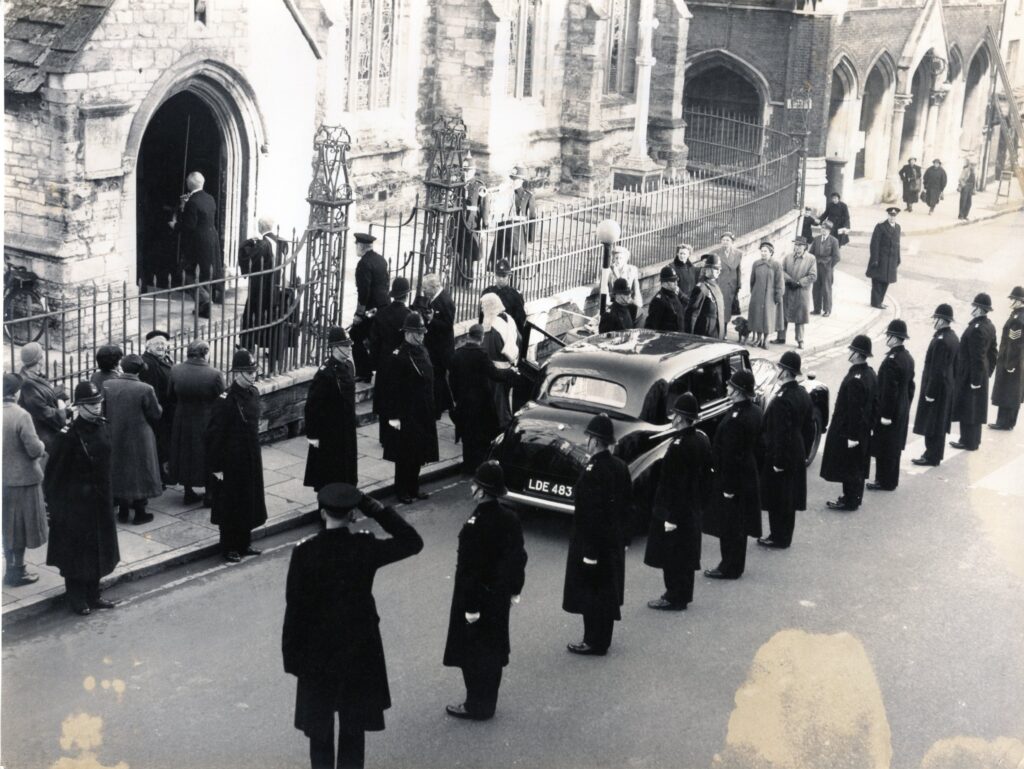
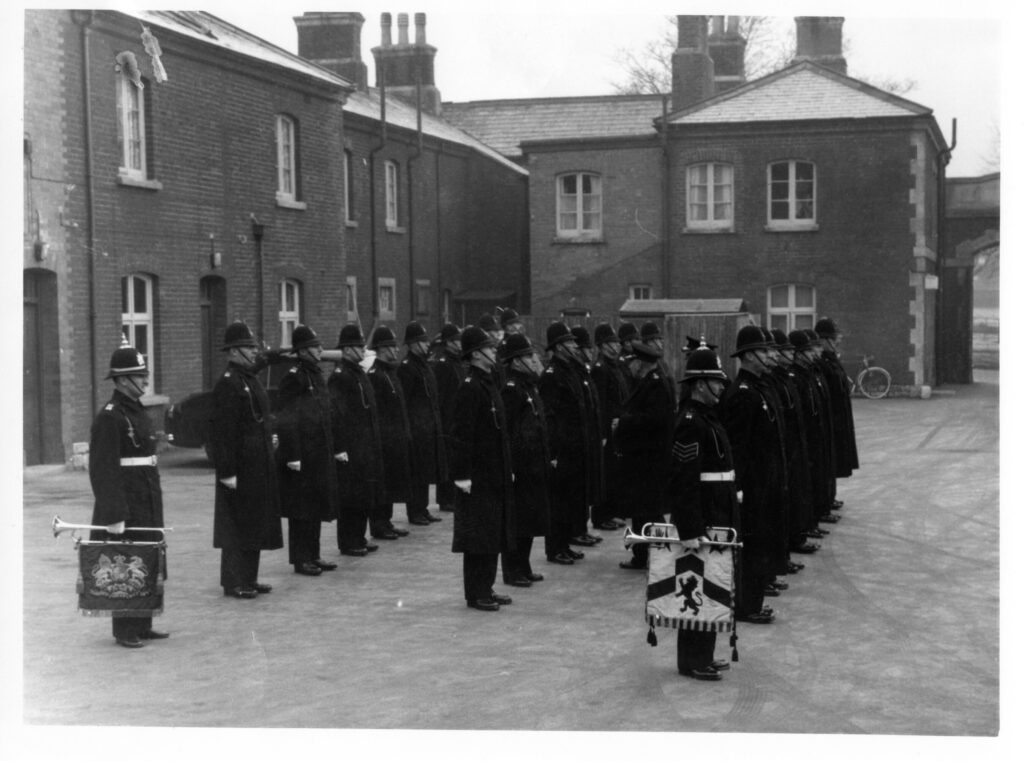 The above photograph is probably from either 1953 or 1954, possibly lent 1954 because they are wearing winter uniform. Chief Constable PEEL YATES and the Insp which is Dick BAIGENT are inspecting the officers, the trumpeters are Sgt Dennis HABGOOD and PC 83 Dave BISHOP. Hayne RUSSELL has identified two officers, at this end of the back row is PC Peter ROOK and at the end of the front row behind Dennis HABGOOD is PC Roy FOOT.
The above photograph is probably from either 1953 or 1954, possibly lent 1954 because they are wearing winter uniform. Chief Constable PEEL YATES and the Insp which is Dick BAIGENT are inspecting the officers, the trumpeters are Sgt Dennis HABGOOD and PC 83 Dave BISHOP. Hayne RUSSELL has identified two officers, at this end of the back row is PC Peter ROOK and at the end of the front row behind Dennis HABGOOD is PC Roy FOOT.
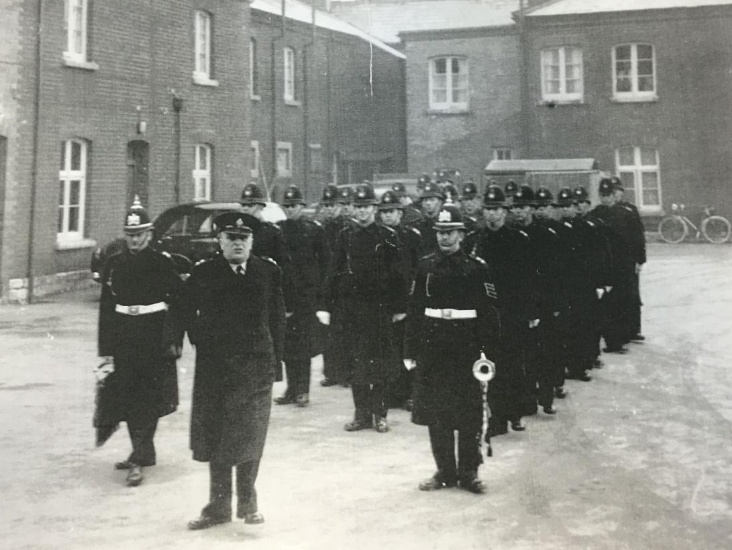
The above photograph appears to be the same day when Insp Dick BAIGENT is ready to march the squad off to High West Street to meet the Judge and his entourage at St Peter’s Church.
The next photograph by deduction is when the Judge is leaving St Peter’s Church to walk up High West Street to the Shirehall. Initially I was stumped by the central figure as if you look closely, he has a “pip” and a crown, which made me think he was a police Chief Superintendent. My first thought was maybe he was the Judges protection from the Met Police as Dorset only recently had introduced the C/Supt rank and I believe, Jack GRAY was the only one. He did not look like Jack so on closer inspection I noticed some other oddities. You can see he has a military sword hidden down the far side of his body and he has a military type collar on his uniform underneath his great coat. His helmet looks more Army than police. It was pointed out to me he could be a Lieu Colonel as they also have a pip and a crown and on checking records the High Sheriff in 1954 was Lt Col Sir Thomas Henry SALT (1905-1965) of Shillingstone House near Blandford. The Mayor behind him will either be Mr D.H NAPIER or Mr H.J. PERRY. The Judge is probably Leonard Austin BYRNE (1896-1965). PC 72 looking on is Doug GIFFORD.
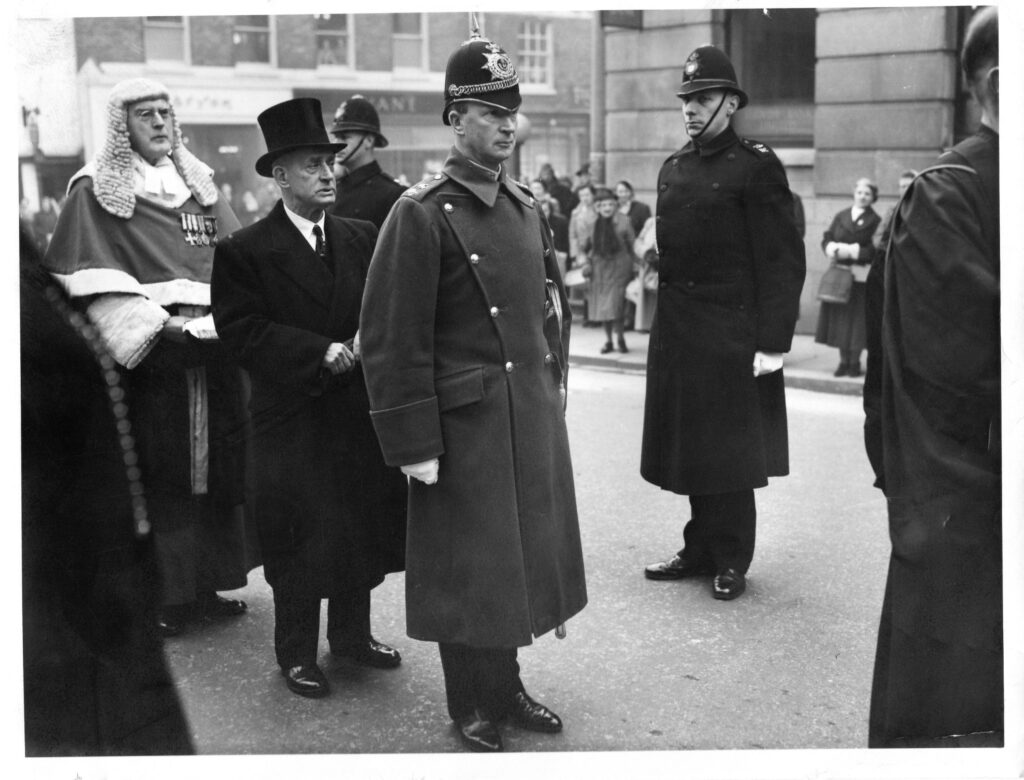
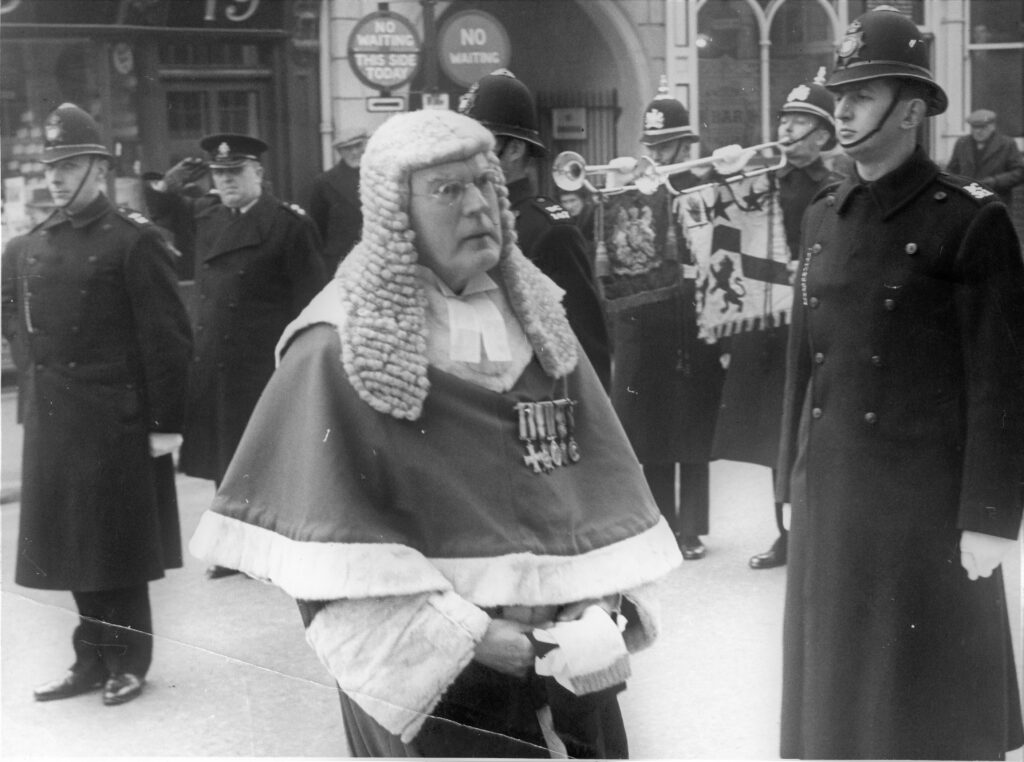
Above you can see the procession later lined up outside the Shirehall and in the background behind the trumpeters is the Royal Oak pub. The Insp saluting is again Dick BAIGENT and the young PC 311, on the right is my father Alistair SWATRIDGE. Next to him blocked out by the Judge is PC 107, which according to my records is Peter HOPER. More information on Peter can be found in another article I am writing called, “The Good the Bad and the Unlucky “.
The next two photographs must be from the Summer court as obviously the officers are not wearing their great coats. The Insp is again Dick BAIGENT with trumpeters Sgt Dennis HABGOOD and PC 83 Dave BISHOP. The Sgt is Frank POWELL and some of the other officers I am informed will be David TAYLOR and Ken OSMOND. Check out the cars, which really do age the photograph and could be older than the 1950’s
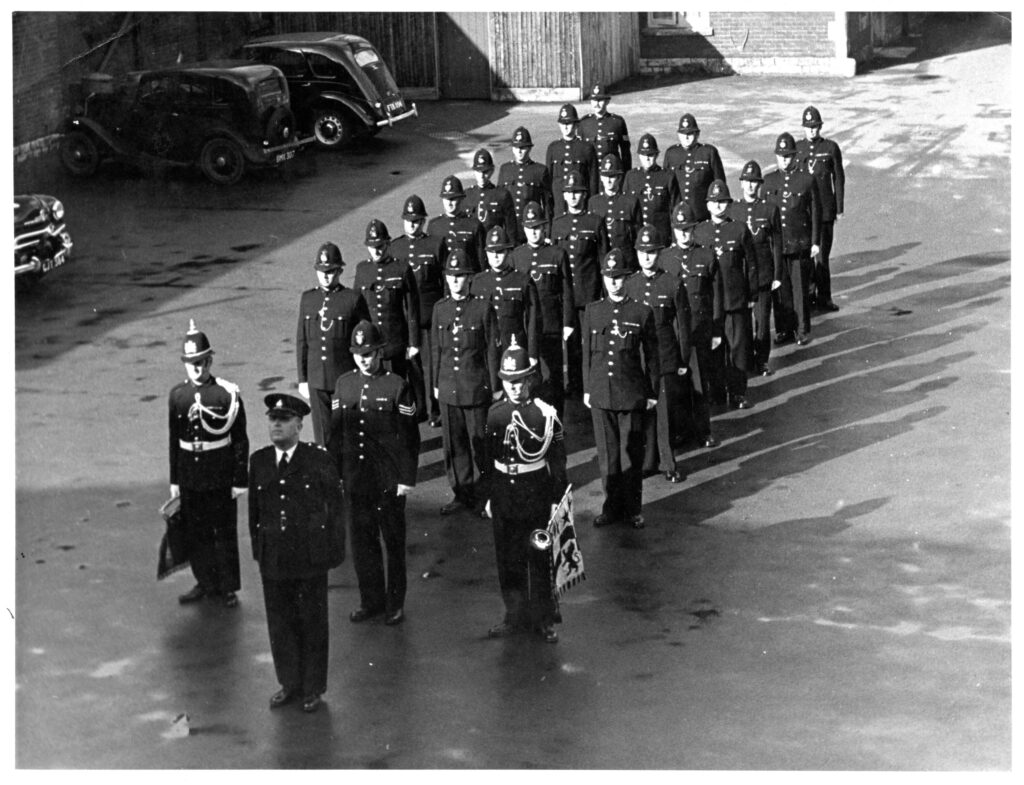
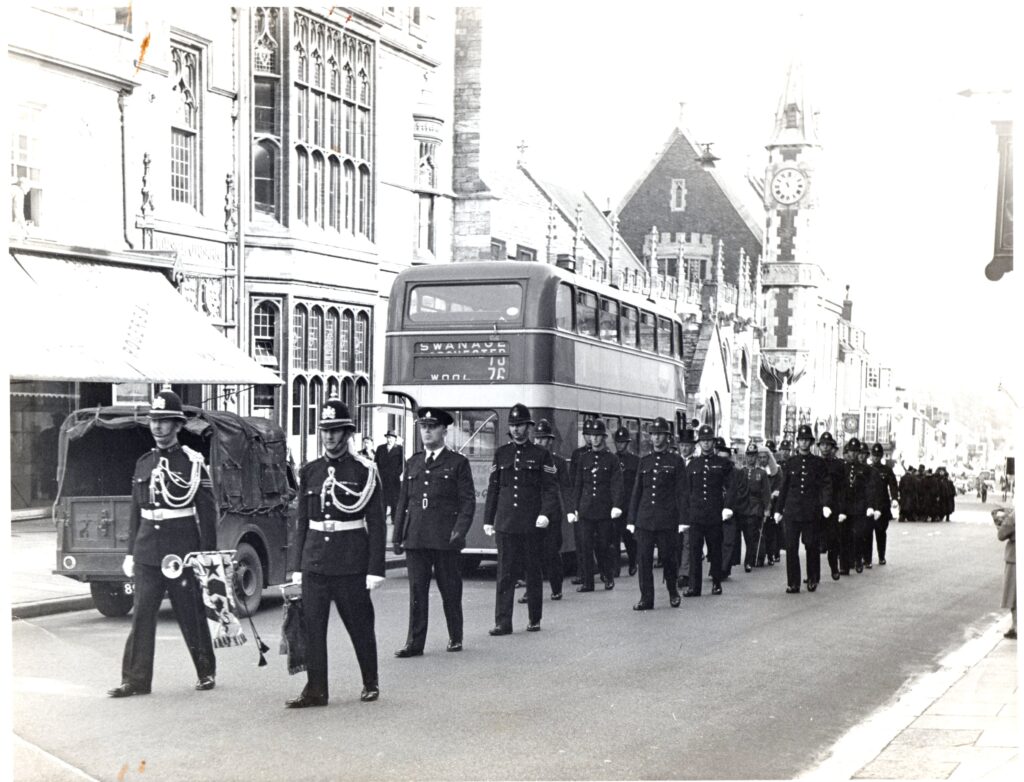
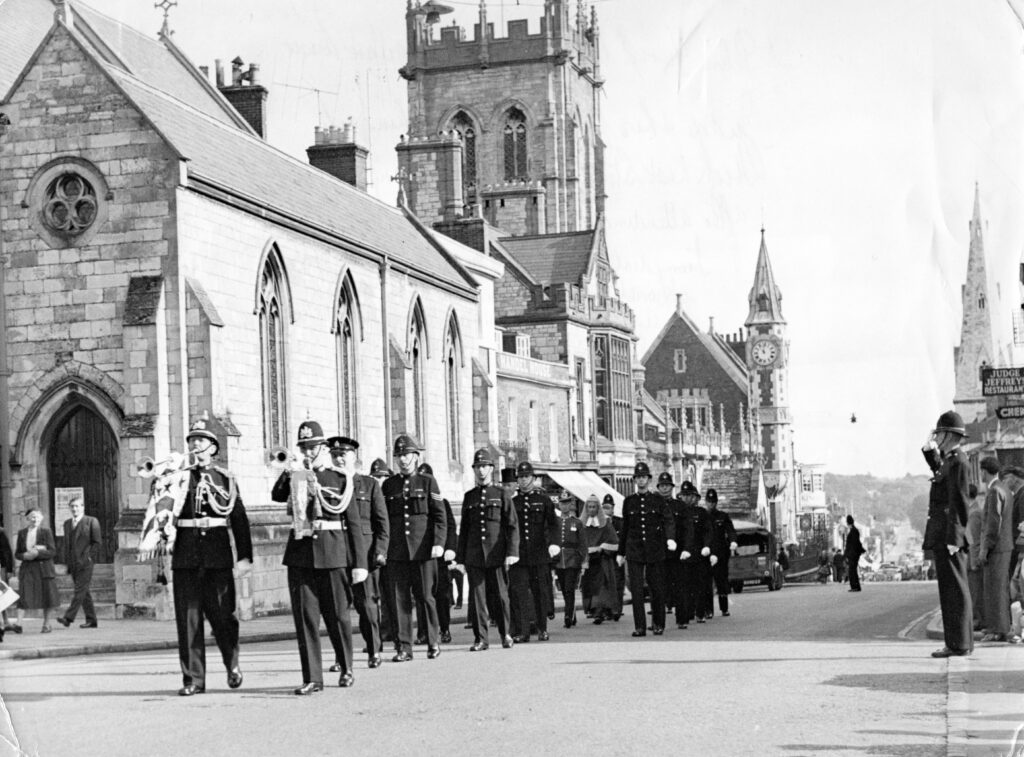
The below photograph is probably from the 1960’s and it looks like PC 334 next to the Judge, who I believe is Christopher RONE, aka PC PLOD.
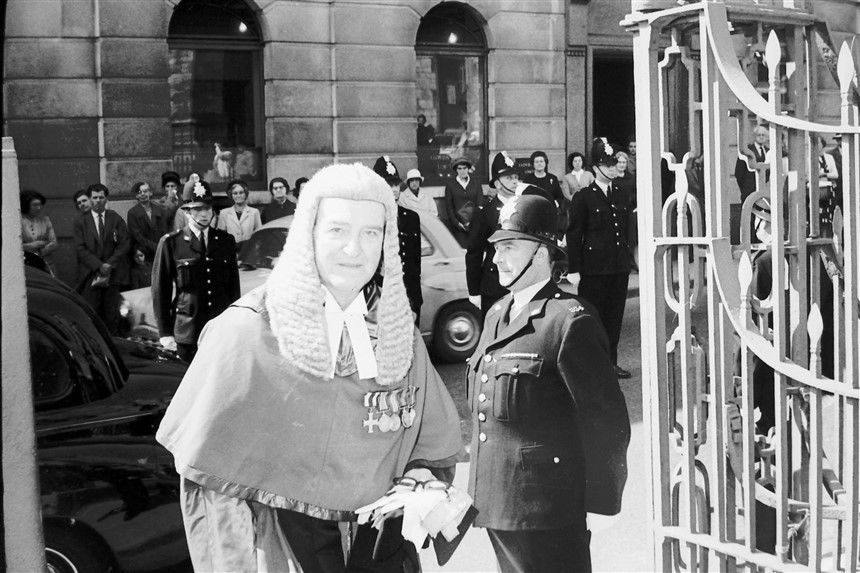
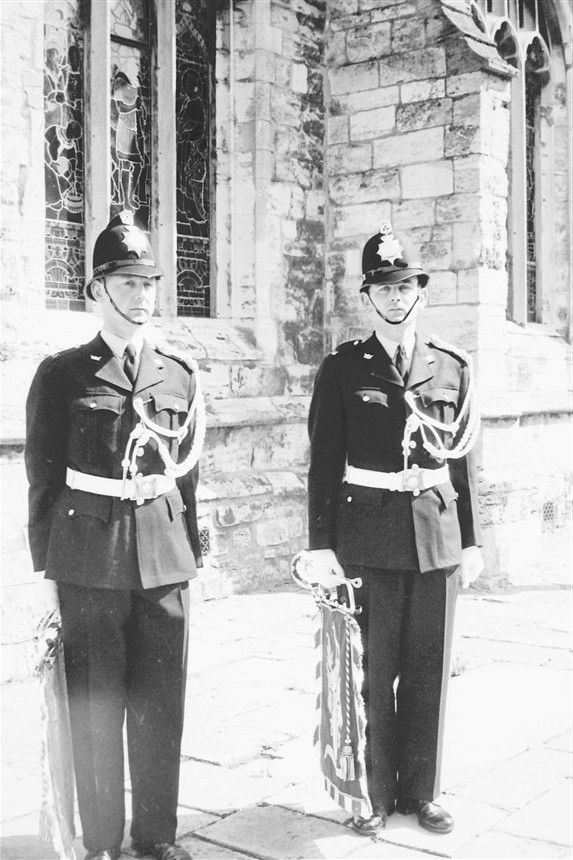
Also from the 1960’s , this photograph shows Pc 155 Walter OLIVER and PC 344 Tommy FARR, who took over from HABGOOD and BISHOP.
The Shire Hall, when it stopped being the main court house reverted to Council Offices but now is a museum. View its internet site if you would like to visit it.
shirehalldorset.org
The site says: Shire Hall Historic Courthouse Museum brings over 200 years of justice and injustice to life. Walk in the footsteps of people whose lives were forever changed in the historic court at Dorchester’s Shire Hall. Immerse yourself in the cells before ascending to the dock. Experience it for yourself.
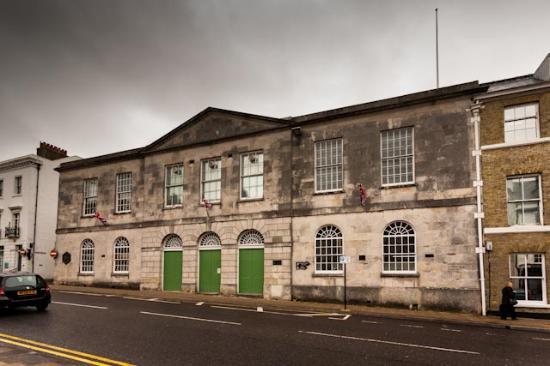
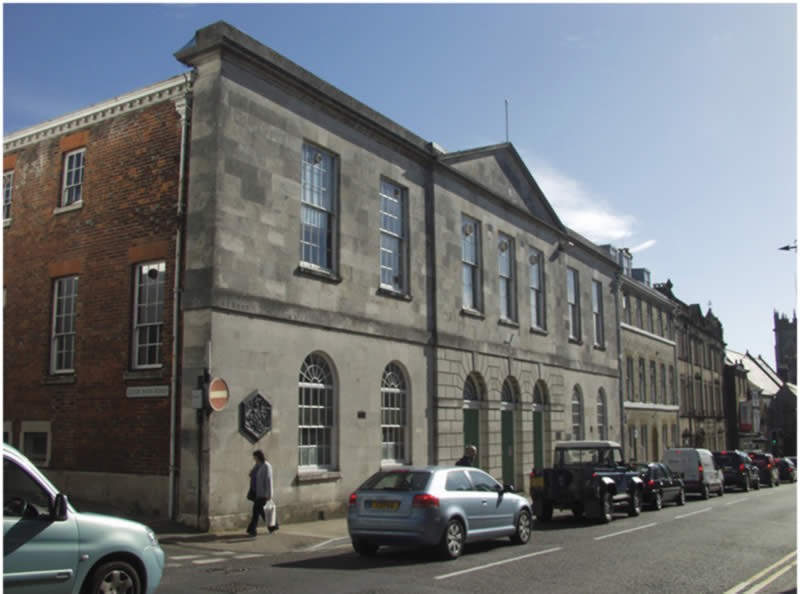
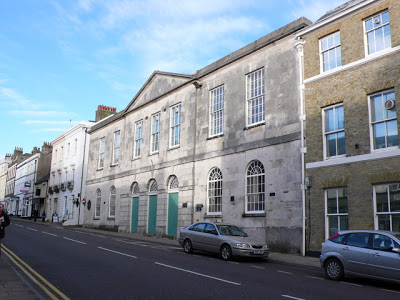
I would like to dedicate this article to ex Sgt Ray SANSOM, who served from 1947- 1974 and passed away aged 93 on 23rd March 2018. Ray wrote his memoirs, “If you want to know the time, ask Ray”.
Hi. I had the pleasure of performing Sgts duties on one of these parades. It was at the ‘new’ Crown Court (Council Offices). I think it was mid 1990s? We marched from High West St to County Hall and I stood smart and tall with another officer on the steps. The trumpeters were two soldiers. Prior to the Judge climbing the steps the soldiers had the giggles. I found out why quite soon! As the Judge approached my ear drums exploded as they did their thing about 4 inches from my face!!
I was deaf for nearly the same length of time I suffered after a Led Zeppelin concert in 1974!
Banter was exchanged with the squaddies and I pondered on it being an injury on duty. On a humorous note two of our least sartorial (scruffy is a better word), we’re ordered to NOT patrol Dorchester town centre whilst his Lordship was in town. Seems a different world now.
( I have photos if wanted).
Regards ex Inspector 722 Alan Jenkins.
Dorset Police 1989 – 2013.
Hello Alan, Interesting especially about the soldiers and the ear drums. I had a similar experience with MOTORHEAD at Poole Arts Cente in the 1970’/80’s. I would have rather been at the Led Zep one as never saw them, Plant on his own was the closest. I am always interested to see any photos you have Alan. All the best IAN. P.S I have just added a new post about WW1 , but I dont think you can add anything to that !!!
I can remember when very young in service going with PC George Washington Hill to the Judge’s lodgings at Hyde Crook, picking him up and taking him to Dorchester. Those of you who new George will appreciate his sombre attitude and po face. A good man to be with
Albert ( Robin ) Backhouse, then PC 205
Hello Albert/ Robin, Thanks for that snippet of information, glad you have contacted me, I will email you
IAN